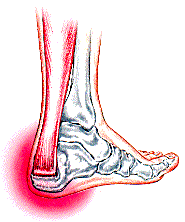Achilles Tendonitis
Source: American Academy of Orthopedic
Surgeons
Synopsis
According to the Greek myth, Achilles
was vulnerable only at his heel. Itís a trait that he must have passed down to
all other humans when he gave his name to the Achilles tendon, which connects
the calf muscles to the heel bone.

The Achilles tendon is the largest
tendon in the human body and can withstand forces of 1,000 pounds or more. But
it is also the most frequently ruptured tendon, and both professional and
weekend athletes can suffer from Achilles tendinitis, a common overuse injury
and inflammation of the tendon.
Any number of events may trigger an
attack of Achilles tendinitis, including:
- rapidly increasing your running
mileage or speed
- adding hill running or stair
climbing to your training routine
- starting up too quickly after a
layoff
- trauma caused by sudden and/or hard
contraction of the calf muscles when putting out extra effort such as in a
final sprint
- overuse resulting from the natural
lack of flexibility in the calf muscles
-
Symptoms of Achilles tendinitis fall
into a common pattern.
- Mild pain after exercise or running
that gradually worsens
- A noticeable sense of sluggishness
in your leg
- Episodes of diffuse or localized
pain, sometimes severe, along the tendon during or a few hours after running
- Morning tenderness about an inch
and a half above the point where the Achilles tendon is attached to the heel
bone
- Stiffness that generally diminishes
as the tendon warms up with use
- Some swelling
-
Because several conditions such as a
partial tendon tear and heel bursitis have similar symptoms, you need to see
your orthopaedic surgeon for a proper diagnosis.
Treatment & Prevention
Treatment depends on the degree of
injury to the tendon, but usually involves
- Rest, which may mean a total
withdrawal from running or exercise for a week, or simply switching to
another exercise, such as swimming, that does not stress the Achilles tendon
- Nonsteroidal anti-inflammatory
medication
- Orthoses, which are devices to help
support the muscle and relieve stress on the tendon such as a heel pad or
shoe insert
- A bandage specifically designed to
restrict motion of the tendon
- Stretching, massage, ultrasound and
appropriate exercises to strengthen the weak muscle group in front of the
leg and the upward foot flexors
-
Surgery is often an option of last
resort. If friction between the tendon and its covering sheath makes the sheath
thick and fibrous, surgery to remove the fibrous tissue and repair any tears may
be the best treatment option. Recovery is slow, may require a temporary cast and
includes a rehabilitation program to avoid weakness.
You may not be able to prevent
Achilles tendinitis, but here are six steps to reduce your risk of incurring an
attack:
- Choose your running shoes
carefully. They should provide sufficient cushion for the heel strike. Using
a prescribed orthotic to change the position of a poorly aligned heel bone
may also help. Perhaps the best precaution is to know your limits and to
follow a sensible program when you exercise.
- Walk and stretch to warm up
gradually before running. Itís better to spend few minutes warming up than
to spend months on the sidelines with a ruptured Achilles tendon.
- Focus on stretching and
strengthening the muscles in the calf.
- Increase your running distance and
your speed gradually, in increments no greater than 10% a week.
- Avoid unaccustomed strenuous
sprinting, hill running and the like.
- Cool down properly after exercise.

